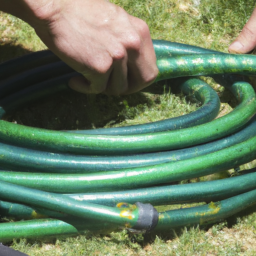How To Roll Up A Garden Hose
Table of Contents []
- How To Roll Up A Garden Hose
- Why Roll Up A Garden Hose?
- The Different Materials of Garden Hose
- Preparing The Hose For Rolling
- The Rolling Process
- Tips For Successfully Rolling Up A Garden Hose
- Insights
- Closing Remarks
How To Roll Up A Garden Hose
How To Roll Up a Garden Hose: An Exhaustive Exploration
Why Roll Up A Garden Hose?
Rolling up a garden hose is not only a useful exercise, it can also help to extend the life of your valuable garden tools and protect them from serious wear and tear. Additionally, rolling up your hose after each use will help maintain a neat and organized outdoor living space, maintain water pressure, and allow for easy retrieval when you need it.
The Different Materials of Garden Hose
Most garden hoses are made from either rubber, vinyl, garden-specific or reinforced-rubberized polyurethane, or plastic. Each material has its own properties and benefits, but because vinyl is lightweight and easy to roll up, vinyl hoses are probably the most popular. There are also specialty hoses, such as soaker hoses, which are made of porous rubber and designed for slow and even watering. Each material has its own advantages and disadvantages, so it pays to research the best hose for your needs.
Rubber Garden Hoses
A rubber garden hose is a great option because it is durable and flexible, so you can store it in tight spaces and maneuver it around without much effort. Keep in mind that rubber hoses can be more expensive than other options, and they can be prone to cracks and leaks. To avoid this, store your hose in a cool and dry place to avoid it from deteriorating prematurely.
Vinyl Garden Hoses
Vinyl garden hoses are a popular choice because of their lightweight and flexible qualities. While vinyl hoses are easy to transport and store, they can be prone to kinks and wear and tear from dragging them around. To help keep your vinyl hose in tip-top shape, store it in a shaded, cool area and avoid twisting it; this can cause it to kink.
Polyurethane Garden Hoses
Reinforced rubberized polyurethane garden hoses are a great lightweight option that are both flexible and strong. This type of hose is more resistant to temperatures, kinking, cracking, and wear and tear than other types of hoses. For best results store you polyurethane garden hose in the shade and away from direct sunlight for optimum performance.
Preparing The Hose For Rolling
Before you roll up your hose, make sure you disconnect it from the faucet and that it is free of tangles and kinks. If there is any water remaining in the hose from last use, use an open palm to push the water away from the faucet end towards the opposite end in order to evenly disperse the water. This will help make the hose easier to roll up and help prevent kinks.
The Rolling Process
Now that your hose is free of tangles and water, you can begin the rolling process. Firstly, check the end for any twists before you start. When you have checked this, hold the garden hose in the air with one hand and begin winding the hose around your other arm. Start by looping the hose over and around your arm from the faucet end. Loop the hose around your arm once and then begin coiling it around your arm. To coil the hose, keep it in one hand and pass it over and around your arm from the outside, scrunching it tightly as you go. Keep coiling until you reach the other end of the hose, then secure it with an adjustable, flexible cable accelerator or a twist tie.
Tips For Successfully Rolling Up A Garden Hose
- Store your hose in the shade and avoid direct sunlight to prolong its life.
- When rolling the hose up, make sure to coil it tightly to stop it from tangling and forming kinks.
- Secure your hose at the end to avoid any slipping or twisting when it needs to be used again.
- If possible, store your hose away from sharp objects so it doesn't become damaged.
Insights
Rolling up your garden hose is an essential step in the maintenance of your garden and outdoor areas. While it's relatively simple, there are several key factors to keep in mind when preparing and rolling your hose! Depending on the material of the hose, it's important to store the hose in the correct area and be wary of excessive twisting and kinking when in use. Additionally, making sure to coat it from end to end prior to rolling is a great way to help avoid kinks and preserve the hose for future use.
Closing Remarks
Rolling up your garden hose with care and precaution is an important part of ensuring your garden and outdoor areas are organized and well-maintained. While the process may seem a little technical, by following the simple directions listed above you can ensure your hose will be rolled up properly and ready for its next use!

Previous Page
Next Page
